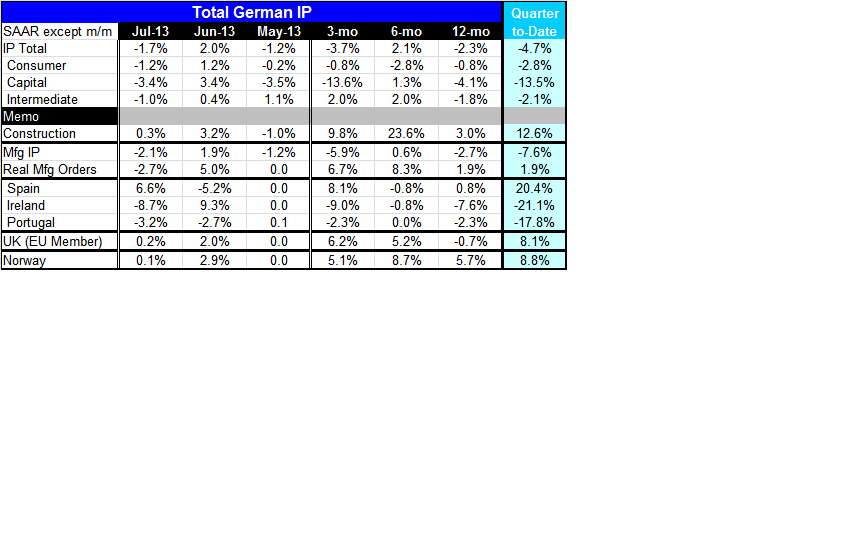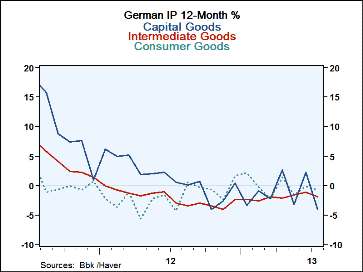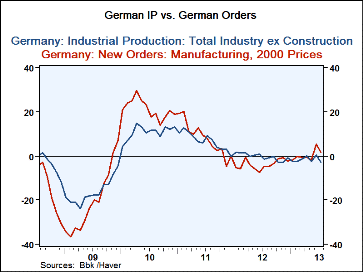 Global| Sep 06 2013
Global| Sep 06 2013German IP Gains Turn Flat
Summary
German IP fell by 1.7% in July after rising by 2% in June. Until June, German seemed to be building momentum in its industrial sector. PMI data are still relatively upbeat. But with the release of the July German IP report, the trend [...]
German IP fell by 1.7% in July after rising by 2% in June. Until June, German seemed to be building momentum in its industrial sector. PMI data are still relatively upbeat. But with the release of the July German IP report, the trend for Germany's industrial sector is much more ambiguous. Instead, of showing IP headed to poke its head above positive growth rates, the chart shows IP cruising along below the surface with all three sectors showing year-over-year rates of growth below zero. Capital goods and consumer goods output have showed sporadic annual gains; but those gains have come and gone leaving no sense that the trend is heading higher for good.
Overall IP is falling at a 3.7% annual rate over three- months, a sharper drop than its Yr/Yr decline. Among the three key sectors Consumer goods, Capital goods and Intermediate goods only intermediate goods output has 3-mo rate of growth that is faster than its Year-over-year pace.
The construction sector is showing growth as well as some acceleration. Construction output rose by 0.3% in July and is up at a 9.8% annual rate over three months. That's much stronger than its 3% gain year-over-year. Still, the pace for construction output over three-months is slower than its six month annualized growth rate of 23.6%.
Industrial output for manufacturing alone is off in July and is off at a 5.9% annual rate; over three months the rate of decline is more than twice its rate of decline over 12-months. However, forward looking real orders are still accelerating. They are up at a 6.7% annual rate over three-months much stronger than their 1.9% gain over 12-months. Real orders trends and actual MFG output are going in opposite directions for now.
The difference between real orders and IP growth rates is illustrated in the chart above. The year-over-year percentage changes show a growing divergence between orders and IP growth. Historically the two series to tend to move together with and R-Squared of 0.84, but with orders led by one month the R-squared value rises to 0.91. With orders lead by two months that rises again to 0.94. Order trends tend to indicate output trends about two months ahead. In May, two months ago, orders fell year over year by 1.8%. Over the next two months real orders turned up. The suggestion from real orders, given this relationship, is that the drop off in German IP is temporary, as real orders are still building some upward momentum. Still, real orders growth is only positive for two months in row. Short term growth for real orders is relatively strong, but over the longer term growth in real orders is still building a base and is not yet solid.

Robert Brusca
AuthorMore in Author Profile »Robert A. Brusca is Chief Economist of Fact and Opinion Economics, a consulting firm he founded in Manhattan. He has been an economist on Wall Street for over 25 years. He has visited central banking and large institutional clients in over 30 countries in his career as an economist. Mr. Brusca was a Divisional Research Chief at the Federal Reserve Bank of NY (Chief of the International Financial markets Division), a Fed Watcher at Irving Trust and Chief Economist at Nikko Securities International. He is widely quoted and appears in various media. Mr. Brusca holds an MA and Ph.D. in economics from Michigan State University and a BA in Economics from the University of Michigan. His research pursues his strong interests in non aligned policy economics as well as international economics. FAO Economics’ research targets investors to assist them in making better investment decisions in stocks, bonds and in a variety of international assets. The company does not manage money and has no conflicts in giving economic advice.








